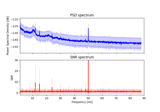mne.datasets.ssvep.data_path#
- mne.datasets.ssvep.data_path(path=None, force_update=False, update_path=True, download=True, *, verbose=None)[source]#
Get path to local copy of ssvep dataset.
- Parameters
- path
None|str Location of where to look for the ssvep dataset. If None, the environment variable or config parameter
MNE_DATASETS_SSVEP_PATHis used. If it doesn’t exist, the “~/mne_data” directory is used. If the ssvep dataset is not found under the given path, the data will be automatically downloaded to the specified folder.- force_updatebool
Force update of the ssvep dataset even if a local copy exists. Default is False.
- update_pathbool |
None If True (default), set the
MNE_DATASETS_SSVEP_PATHin mne-python config to the given path. If None, the user is prompted.- downloadbool
If False and the ssvep dataset has not been downloaded yet, it will not be downloaded and the path will be returned as ‘’ (empty string). This is mostly used for debugging purposes and can be safely ignored by most users.
- verbosebool |
str|int|None Control verbosity of the logging output. If
None, use the default verbosity level. See the logging documentation andmne.verbose()for details. Should only be passed as a keyword argument.
- path
- Returns
- pathinstance of
pathlib.Path Path to ssvep dataset directory.
- pathinstance of
Examples using mne.datasets.ssvep.data_path#

Frequency-tagging: Basic analysis of an SSVEP/vSSR dataset